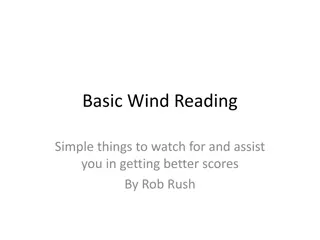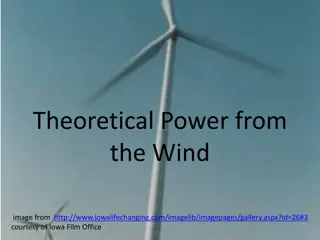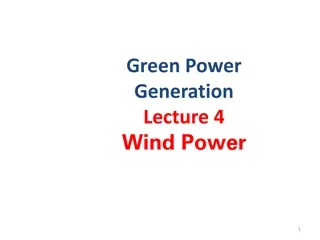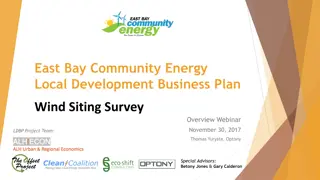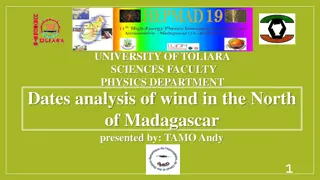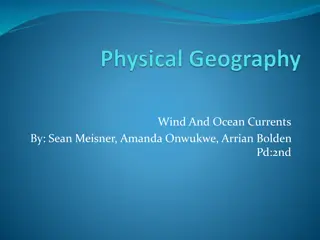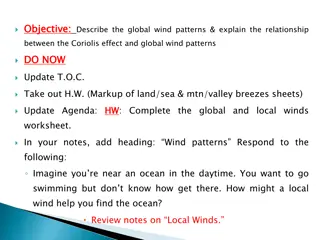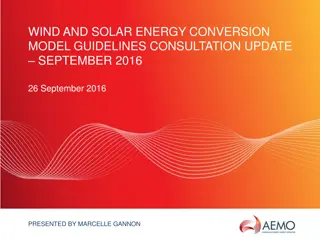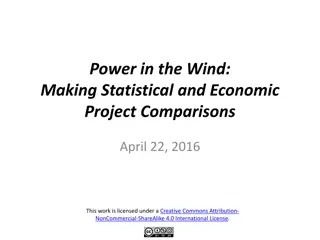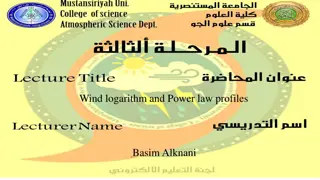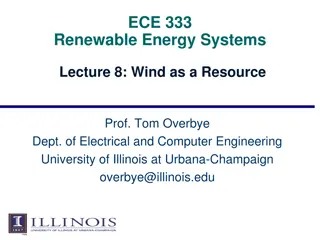Understanding Local Wind Patterns and Formation
Local winds are a significant type of wind caused by variances in air temperature, often developing throughout the day due to solar heat. Land and sea breezes, mountain and valley breezes, Chinook and Santa Ana winds, and country breezes are examples of local wind patterns formed under different conditions. These patterns are influenced by the heating and cooling of surfaces, leading to distinct circulation systems and airflow directions. By understanding these phenomena, we gain insight into the complexity of Earth's atmospheric processes and their impact on local climates.
Uploaded on Sep 21, 2024 | 0 Views
Download Presentation

Please find below an Image/Link to download the presentation.
The content on the website is provided AS IS for your information and personal use only. It may not be sold, licensed, or shared on other websites without obtaining consent from the author. Download presentation by click this link. If you encounter any issues during the download, it is possible that the publisher has removed the file from their server.
E N D
Presentation Transcript
What are Local winds? Local winds are one of the main types of winds caused by differences in air temperature. The temperature differences often develop through the day as the sun heats the air and land, but they can also be formed when surfaces do not heat or cool evenly
How are the following local wind patterns formed? Land and sea breezes Mountain and valley breezes Chinook and Santa Ana winds Country breeze
Land and sea breezes Sea and land breezes are types of thermal circulation systems that develop at the interface of land and ocean. During the daytime land heats up much faster than water as it receives solar radiation from the Sun . The warmer air over the land then begins to expand and rise forming a thermal low. Daytime
At sunset, the land surface stops receiving radiation from the Sun . As night continues the land surface begins losing heat energy at a much faster rate than the water surface. Wind flow now moves from the land to the open ocean. This type of localized air flow is called a land breez Night time
Mountain and valley breezes A valley breeze develops during the day as the Sun heats the land surface and air at the valley bottom and sides. As the air heats it becomes less dense and buoyant and begins to flow gently up the valley sides. Day time
Mountain and Valley Breezes During the night, the air along the mountain slopes begins to cool quickly because of long wave radiation loss it becomes more dense and begins to flow downslope causing a Mountain breeze Night time
Chinook and Santa Ana winds Chinook wind- warm, westerly wind found in western North America- Canada and the USA, when air from the Pacific blows over the Rocky Mountains and other upland areas. Santa Ana winds- hot, dry, strong, blustery, f hn-type wind which blows from the north-east or east over southern California and carries with it large quantities of dust http://www.google.co.kr/
Country breeze One of local wind called a country breeze is associated with large urban area As the name implies this circulation pattern is characterized by a light wind blowing into the city from the surrounding country side
How do these local wind patterns affect our daily lives? Tornado yellow dust typhoon Hurricane
reference http://www.ask.com/science/local-winds-45330ad2a772b05 http://www.upf.br/comarte/?p=584 http://www.physicalgeography.net/fundamentals/7o.html http://www.atmo.arizona.edu/students/courselinks/fall09/nats101s2/lect ure_notes/nov13.html https://reginnovations.org/wind-energy/wrf-wind-simulation-wind- energy-production-estimates-forced-different-reanalyses-comparison- observed-datafor-portugal/ http://www.weatherwizkids.com/weather-wind.htm http://www.mymodernmet.com/profiles/blogs/list/tag/sandstorm http://www.fractaluniverse.org/v2/?page_id=145



